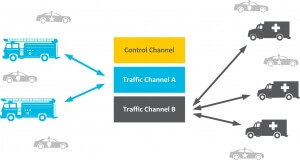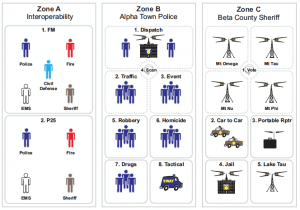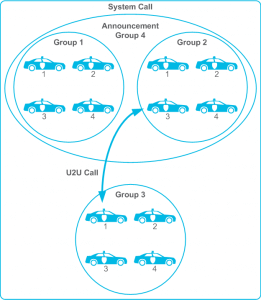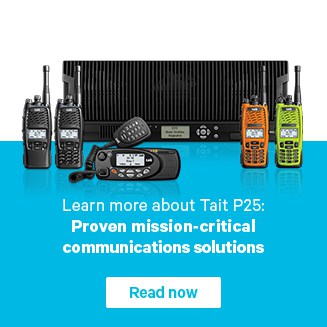Introduction to P25
P25 Standard
Introduction to P25 Trunking
In the Basic Radio Awareness course, we introduced the basic principles of trunking.
Unlike conventional radio, a pool of channels is available for communication that are allocated for groups on the network. Trunking uses channels much more effectively than conventional systems, where a channel is required for each group.
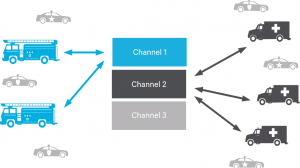
Conventional operation
Trunking is frequently used by public safety for the large statewide networks, allowing a pool of channels to be shared by a large number of public safety agencies, without the need for each agency to source their own channels for communication. It enables logical groups or teams of people to be added to the network by allocating an ID for that group to communicate on, rather than having to allocate a particular radio channel. That group can be available throughout the entire coverage area of the system, rather than being restricted to particular geographic areas.
Trunking also allows additional features, such as emergency preemption. This enables call prioritisation. When someone is in a life-threatening situation, a low priority routine conversation will be preempted or taken over by an emergency call. A pool of channels enables continued communications should a fault or network outage occur, decreasing the likelihood of one group losing communication abilities.
A P25 radio on a trunked network operates very similarly to the way a P25 radio on a conventional network operates. Often, you select the group that you’re going to talk on by using the channel selector at the top, and you press the “push to talk”, or “PTT” button to communicate, just as you would select a conventional channel to communicate on that channel.
The actual operation of trunking is almost transparent to the user. The main difference that you may notice is a “go ahead” beep, which tells you when a channel has been allocated and your communication can start. If you’re configuring a radio for a trunked statewide network, one of the terms that you might be familiar with is a WACN or a Wide Area Communication Network number and a system ID.
This defines or identifies that particular trunked network. So, when you turn your radio on, it knows which network to use for communication because it’s possible for there to be more than more than one P25 network in a particular area. For example, there might be a statewide network, as well as a separate local network operating in the city. Many of the features of P25 are available in both conventional and trunked operation.
Talk group calls (a one-to-many call), as well unit-to-unit calls are supported on trunking. There’s also announcement group calls, which is a call to a large group of groups on the network. Some trunked systems also support dynamic regrouping, where teams of people can be allocated dynamically from the dispatch center as new incidents occur, rather than having to be pre-programmed in the radio.
In summary, the Basic Radio Awareness course introduced the principles of trunking, that trunking is a more efficient use of the available radio spectrum. For P25, the benefits of trunking often come down to:
- emergency calls,
- the dynamic allocation of teams,
- the ability to share resources between different public safety organizations sharing the cost,
- maximizing the coverage of the radio system.
 Radio Academy
Radio Academy
